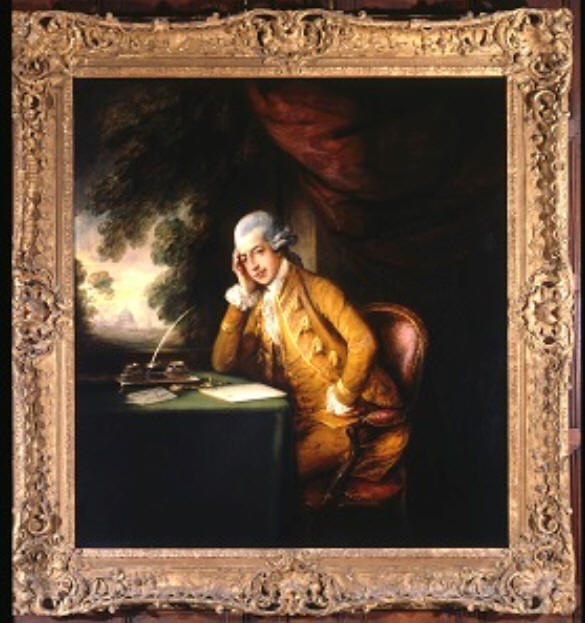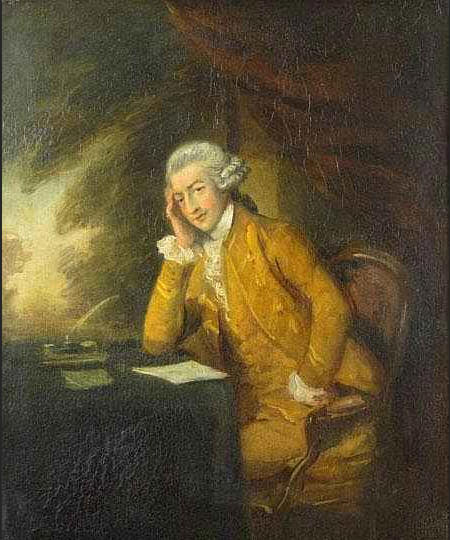

With permission of the Newport Restoration Foundation, 51 Touro Street, Newport RI
This painting of Raphael Franco #1203 painted by Thomas Gainsborough in 1780 was first seen by us in black and white as plate 23 of ref 47 which informs us on page 24 that the original is an unsigned portrait and that the subject was dressed in a yellow coat, vest and breeches; and that it has St Paul's Cathedral in the background. Footnote 1 on page 24 of ref 47 informs us that the original was listed as #267 by ref 156 which in turn informs us that it measures 60 by 56 inches. Further, ref 47 suggests that it fetched 6,200 guineas in 1910 and that nothing is known of this painting subsequently. However, on 17 Jun 2015 we learned from George Lopes (via Alan Pereira) that the painting belonged to Doris Duke who was a BAT heiress and that he saw it around 1980 in her Rough Point residence at Newport RI. We now know that it was bought on 8 July 1910 by her father James B Duke from Christie, Manson & Woods and that the sale was 'part of the estate of Sholto Montgomery Cay the Earl of Morton'. Of course, the Earls of Morton were quite eminent - the 14th Earl (James Douglas 1709-68) was President of the Royal Society at the time when the eminent explorer James Cook consulted him (see ref 299). But the gallery sinned, for while thepeerage.com shows the wife of the 16th Earl of Morton was Susan Elizabeth Buller-Yarde-Buller (who was the aunt of Bertha Yarde-Buller #437 who was the wife of a great-grandson #419 of Raphael Franco), it does not include Sholto Montgomery Cay among the 22 Earls of Morton. That is, while there was a remote link between the painting and the 16th Earl of Morton, the gallery invented a provenance and an imaginary Earl of Morton! The 16th Earl was George Douglas 1774-1827, the 17th Earl was George Sholto Douglas 1827-58, the 18th Earl was Sholto John Douglas 1858-84, the 19th Earl was Sholto George Douglas 1884-1935), while the 20th Earl was Sholto Charles John Hay Douglas 1935-1976. The portrait hung in the Duke’s New York mansion at 78th Street until around 1958, at which time Doris Duke and her mother Nanaline gifted the house to the NYU Institute of Fine Arts. At that time, the portrait was sent to be hung at Rough Point, which Doris Duke was in the process of redecorating. She hung it in the Great Hall of Rough Point, where it remains to this day. Upon her death it became the property of the Newport Restoration Foundation.
We have not studied the connection between Esther Touro nee Baruch Lousada d1756 Kingston, the sister of Jacob #380 and Emanuel #41, and the Touros of Rhode Island, the first of which was the Hazan Isaac Touro b1738 Amsterdam d8 Dec 1783 Kingston. However, we have been able to show that he was a second cousin of Judith d'Aguilar who married Isaac Baruch Lousada (this marriage is shown here). This link with the Touros was via the da Fonseca family and is shown here. The Hazan Isaac Touro left Amsterdam in 1758 for Jamaica but then arrived in Newport in 1760 where shortly afterward the Touro Synagogue was built. He was a loyalist, survived in New York on British charity, and ultimately moved to Jamaica in 1782 just as the British/American peace agreement was being finalised. His sons Abraham and Judah were renowned philanthropists. We wonder whether Isaac Touro would have changed his allegiance to Britain had he lived long enough, for in Aug 1790, newly inaugurated President George Washington visited the Touro Synagogue on one of his trips to forge the new nation. He was well received and thanked for leading 'a Government, which to bigotry gives no sanction, to persecution no assistance'. Washington's somewhat aspirational letter in response (so we learn from ref 208) became one of the great documents in American history and stated that America had established 'an enlarged and liberal policy: a policy worthy of imitation. All possess alike liberty of conscience and immunities of citizenship'. It also said America had created true religious liberty, where 'every one shall sit in safety under his own vine and figtree, and there shall be none to make him afraid'.
This image above was found by Alan Pereira on http://www.invaluable.com/